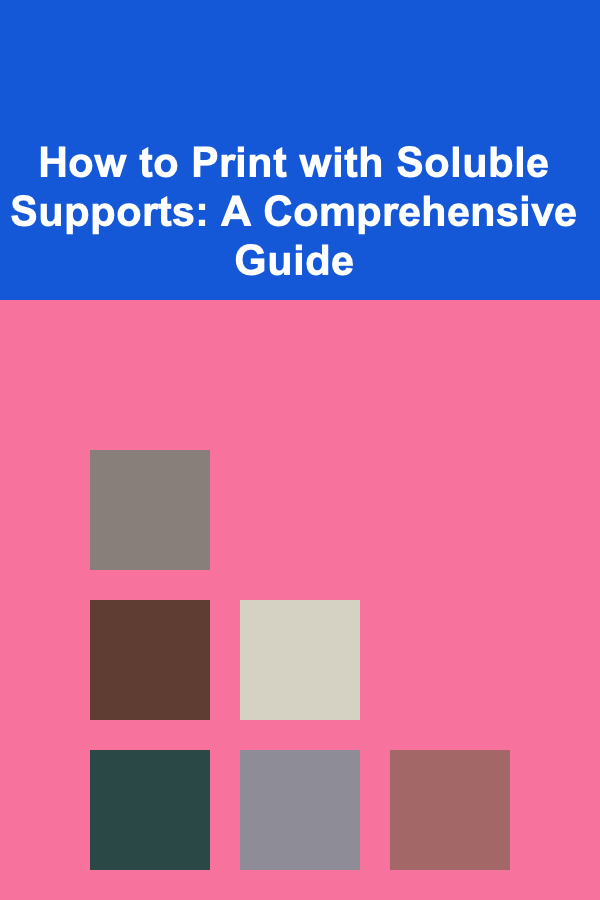
How to Print with Soluble Supports: A Comprehensive Guide
ebook include PDF & Audio bundle (Micro Guide)
$12.99$6.99
Limited Time Offer! Order within the next:

3D printing has revolutionized the manufacturing and prototyping industries by providing an efficient, cost-effective way to create complex geometries and structures. However, as the capabilities of 3D printers have grown, so too has the need for advanced techniques to support these intricate designs. One such technique involves the use of soluble supports, a game-changing method that enables the creation of highly detailed parts with complex overhangs and cavities. This article will dive deep into the concept of soluble supports in 3D printing, including their benefits, materials, best practices, and troubleshooting tips.
What Are Soluble Supports?
Soluble supports are a type of temporary structure used in 3D printing to prevent deformation or collapse during the printing process. These supports are designed to be easily removed after the print is complete, typically by dissolving them in a specialized solution. Soluble supports allow printers to create complex, organic shapes with intricate overhangs, voids, and delicate features that would otherwise be impossible to print using traditional support structures made from the same material as the print.
The Importance of Support Structures in 3D Printing
In most 3D printing methods, particularly Fused Deposition Modeling (FDM), certain parts of the model may not have enough material underneath them to maintain their shape during the printing process. These overhanging or unsupported sections would collapse under their own weight without external support.
Traditional support structures are often made from the same material as the printed object, which requires manual removal after the print is finished. While effective, these supports can leave marks, scratches, or even damage the print if not carefully removed. Soluble supports address this problem by using a different material that can be dissolved after printing, leaving behind a clean, undamaged surface.
How Do Soluble Supports Work?
Soluble supports are printed alongside the object using a different material that is designed to dissolve in water or a specific chemical solution. The support material must be compatible with the primary printing material and should not interfere with the print's overall quality.
During the printing process, the 3D printer lays down the support material in areas where overhangs, cavities, or other challenging geometries require additional support. Once the print is complete, the soluble material is immersed in water or a solvent (such as a specialized dissolving solution), where it breaks down and disappears, leaving the object free from any visible supports.
This method of support removal allows for more complex and intricate designs without the risk of damaging the finished part during the post-processing phase.
Types of Soluble Support Materials
The key to using soluble supports successfully lies in choosing the right support material for the job. Several soluble materials are commonly used in 3D printing, each with its own set of characteristics. Here are the most popular soluble support materials:
1. PVA (Polyvinyl Alcohol)
PVA is one of the most commonly used soluble support materials in 3D printing. It is water-soluble, meaning it can be dissolved in warm water, making it ideal for creating temporary support structures. PVA is compatible with a wide range of materials, particularly PLA, and is known for its ease of use and availability.
-
Advantages of PVA:
- Water-soluble, easily removed.
- Compatible with PLA and other materials.
- Provides good adhesion to the primary print material.
- Works well for intricate, delicate parts.
-
Disadvantages of PVA:
- Sensitive to moisture, requiring careful storage.
- Not as durable or strong as other support materials.
2. HIPS (High Impact Polystyrene)
HIPS is another popular support material for 3D printing, often used in combination with ABS (Acrylonitrile Butadiene Styrene). HIPS is soluble in a solution of Limonene, a citrus-based solvent, which makes it an excellent choice for dissolving supports.
-
Advantages of HIPS:
- Works well with ABS and other materials.
- Strong and durable.
- Easily dissolved in Limonene.
-
Disadvantages of HIPS:
- Requires the use of a specific solvent (Limonene), which may not be as readily available as water.
- Has an odor when dissolved.
3. BVOH (Butenediol Vinyl Alcohol Copolymer)
BVOH is a relatively newer support material designed to offer superior solubility and strength compared to PVA. It dissolves in water, making it a viable option for those looking for an alternative to PVA. BVOH works well with a range of filament types, including PLA, PETG, and ABS.
-
Advantages of BVOH:
- High solubility in water.
- Suitable for a variety of filament types.
- Provides excellent support for complex prints.
-
Disadvantages of BVOH:
- More expensive than PVA.
- Requires proper storage to prevent moisture absorption.
4. PLA (Polylactic Acid)
PLA is a common filament material used in 3D printing, and while it is not typically used as a soluble support material on its own, it can be paired with PVA or other soluble materials. PLA supports dissolve easily when using PVA as the main support material, making this combination popular for beginners.
-
Advantages of PLA:
- Biodegradable and eco-friendly.
- Available in a wide range of colors.
- Easy to print and widely compatible.
-
Disadvantages of PLA:
- Can be brittle, so it may not provide strong support for certain designs.
The Process of Printing with Soluble Supports
Printing with soluble supports involves a few additional steps compared to standard 3D printing, but with careful attention to detail, it can yield remarkable results. Here is a step-by-step guide to printing with soluble supports:
1. Select the Right Printer and Materials
Not all 3D printers are compatible with soluble supports, so it's important to ensure that your printer can handle dual-material printing. Most FDM printers equipped with a dual extrusion system are capable of printing with soluble supports, as they can print two different materials simultaneously.
- Printer Requirements :
- A dual extrusion 3D printer.
- A print bed that can accommodate dual-material prints.
- Appropriate slicer software that can support soluble material settings.
2. Load the Filaments
Once you have selected the appropriate soluble support material (such as PVA or HIPS), load both the support material and the primary print material (such as PLA or ABS) into the printer's respective extruders. Ensure the print head is clean, and the materials are properly fed into the printer.
3. Configure the Print Settings
When preparing the print in slicer software (such as Cura, PrusaSlicer, or Simplify3D), you will need to specify the use of soluble supports and set the correct parameters for both the primary and support materials. This includes:
- Support material type: Specify the soluble material (e.g., PVA, HIPS).
- Support density: Adjust the density to balance support strength and ease of removal.
- Extruder settings: Set appropriate temperatures for both materials. For instance, PVA requires a lower extrusion temperature than PLA.
- Print speed: Reduce the print speed for better quality and support adhesion.
4. Print the Object
Begin the print process. The printer will first print the object using the primary filament, then print the support structures with the soluble material. Ensure that the printing environment is free from drafts or disturbances, as these can affect the adhesion and quality of the print.
5. Post-Processing: Dissolving the Supports
Once the print is complete, the soluble supports must be removed. The method for doing so depends on the support material used:
- PVA: Immerse the print in warm water (ideally around 60°C) for several hours, checking periodically to ensure the supports have dissolved completely.
- HIPS: Submerge the print in a container filled with Limonene, ensuring it is fully covered. Let the print sit in the solution for several hours or until the supports dissolve.
- BVOH: Similar to PVA, BVOH can be dissolved in warm water. However, it may dissolve faster, so regular monitoring is required.
Best Practices for Printing with Soluble Supports
Printing with soluble supports can be tricky, but following these best practices will help improve the quality of your prints and make the process smoother:
- Test Your Materials: Before printing large or complex models, run tests to ensure the soluble support material works well with your primary filament.
- Ensure Proper Storage: Soluble materials like PVA and BVOH are highly sensitive to moisture. Store them in a dry, sealed container to prevent degradation.
- Use the Right Temperature: Ensure that the extrusion temperatures for both materials are set correctly to prevent clogging or poor adhesion.
- Consider Support Density: Use a lower density for supports to make removal easier and faster, though be mindful that too low of a density may result in insufficient support.
- Clean After Every Print: Always clean your extruders thoroughly after printing with dual materials to prevent any cross-contamination.
Troubleshooting Common Issues
1. Poor Adhesion Between Support and Print
If the soluble support material doesn't adhere properly to the object, the supports may detach prematurely during printing, causing the object to fail. Ensure that both materials are compatible and properly calibrated. Use the slicer settings to optimize adhesion.
2. Incomplete Removal of Supports
If the soluble supports are not dissolving completely, increase the water temperature or extend the dissolution time. For HIPS, make sure you're using the right solvent (Limonene), and for PVA, use warm water at the recommended temperature.
3. Clogs and Extrusion Issues
Clogging can occur if the soluble material isn't feeding properly into the extruder. Regularly clean the print head and ensure the material is dry before use. If the issue persists, check the filament diameter and extruder settings.
4. Overhangs and Unsupported Regions
While soluble supports allow for complex designs, overhangs and unsupported regions still require adequate support to prevent sagging. Ensure that your slicer settings are optimized to provide enough support material for these areas.
Conclusion
Printing with soluble supports opens up a new world of possibilities for 3D printing, allowing for the creation of intricate, highly detailed objects without the constraints of traditional support methods. By using soluble materials like PVA, HIPS, or BVOH, and following the best practices outlined in this guide, you can achieve cleaner, more complex prints with minimal post-processing. With the right tools and knowledge, soluble supports can help you unlock the full potential of 3D printing and take your designs to the next level.

How to Create a Budget-Friendly Home Security Plan Using Bosch Security Systems
Read More
How to Create a Crisis Management Checklist for Customer Service
Read More
Optimizing Healthcare Systems: Strategies and Solutions for Healthcare Consultants
Read More
Risk Management in Finance: Insights and Practices for Effective Financial Analysts
Read More
How to Confit Meats and Vegetables
Read More
How to Build Community Resilience to Extreme Weather
Read MoreOther Products

How to Create a Budget-Friendly Home Security Plan Using Bosch Security Systems
Read More
How to Create a Crisis Management Checklist for Customer Service
Read More
Optimizing Healthcare Systems: Strategies and Solutions for Healthcare Consultants
Read More
Risk Management in Finance: Insights and Practices for Effective Financial Analysts
Read More
How to Confit Meats and Vegetables
Read More